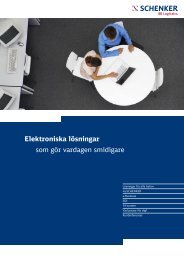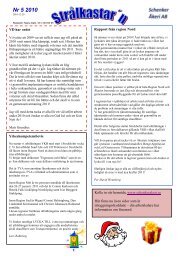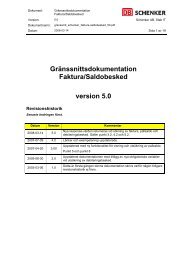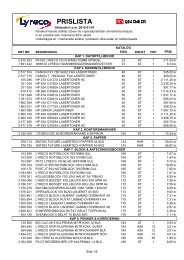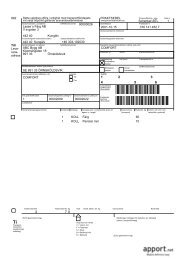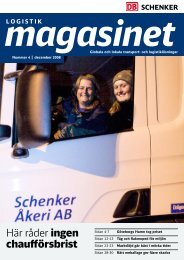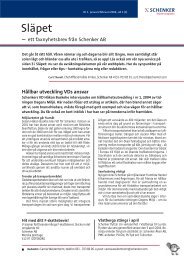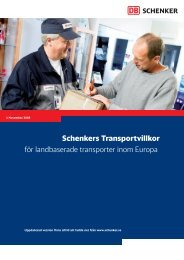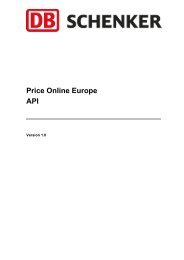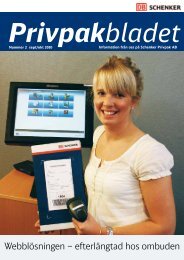Ecological Transport Information Tool for Worldwide ... - Schenker
Ecological Transport Information Tool for Worldwide ... - Schenker
Ecological Transport Information Tool for Worldwide ... - Schenker
Create successful ePaper yourself
Turn your PDF publications into a flip-book with our unique Google optimized e-Paper software.
Page 64<br />
IFEU Heidelberg, Öko-Institut, IVE, RMCON<br />
Table 37: Typical characteristica of inland vessels.<br />
Vessel type<br />
Cargo<br />
capacity [t]<br />
TEU<br />
capacity<br />
ME power<br />
[kW]<br />
Aux power<br />
[kW]<br />
Engine<br />
example<br />
Fuel consumption<br />
g/kWh 8<br />
IV, Neo K 655 N/A 336 102 1x Cat 3408C 229<br />
IV, Europaship 1 350 (100) 650 260 1x Cat 3508B 223<br />
Va, RoRo, Container 2 500 200 1 140 456 1x Cat 3512 211<br />
Va, Tankship 3 000 N/A 1 460 585 1x Cat 3516 212<br />
VIa, JOWI ship 5 500 470 - 500 3 200 1 000 2x Cat 3516 212<br />
VIb, Push Convoy<br />
(4 units)<br />
7–16 000<br />
(11 000)<br />
1 100 4 000 1 200 3x Cat 3516 209<br />
The two river categories (IV) are used in EcoTransIT World and two distinct aggregate<br />
averages are build. The aggregate emission factors were build by weighting the different<br />
vessel sizes and combining them to a vessel class IV (Europaship and Neo K) and vessel >IVa.<br />
It is assumed that on rivers of category V and up both Europaship vessels and larger vessels<br />
can be found. Thus the category >IV includes the Europaship-type vessels. Vessels smaller<br />
Neo K vessels are not considered in EcoTransIT World because of their minor role in freight<br />
transport.<br />
EcoTransIT World does not take the direction of travel into account in order to treat all modes<br />
of transport similar 9 . The principle of EcoTransIT World is that differences on transport legs are<br />
averaged over the entire leg because it is assumed that the transport purchaser can not be<br />
made responsible <strong>for</strong> different per<strong>for</strong>mances in particular directions but has to bear responsibility<br />
<strong>for</strong> the average per<strong>for</strong>mance. For example differences in capacity utilization are averaged<br />
over the entire return leg. Similarly is the fuel consumed per distance travelled in flowing rivers,<br />
such as the Rhine, averaged. Different fuel consumptions per distance up- and down-river are<br />
respectively not considered. A transport purchaser takes responsibility of the average per<strong>for</strong>mance<br />
regardless of the direction of the transport.<br />
5.4.2 Emission factors <strong>for</strong> inland vessels<br />
Marine engines installed be<strong>for</strong>e 2002 in Europe and 2004-07 in North America are so called<br />
Tier 1 engines. To date, due to the average age of inland vessels, the emission Tier 2 standards<br />
play practically no role. In the Planco study /2007/ emission factors were averaged over<br />
vessel classes in dependence to their age profile using a regression analysis <strong>for</strong>m the Tier 2<br />
regulations. However, the resulting emission factors even <strong>for</strong> those vessels in class categories<br />
of old age are not significantly above the Tier 2 limits. Emission factors <strong>for</strong> Category 1 engines<br />
prior to regulation were used in <strong>for</strong> emissions inventory of inland water traffic in the Great Lakes<br />
8<br />
9<br />
Including a +5 % tolerance.<br />
Ocean going vessels and aircrafts too have different fuel consumptions over ground depending on<br />
ocean currents and winds.<br />
EcoTransIT World: Methodology and Data – July 15 th , 2010



